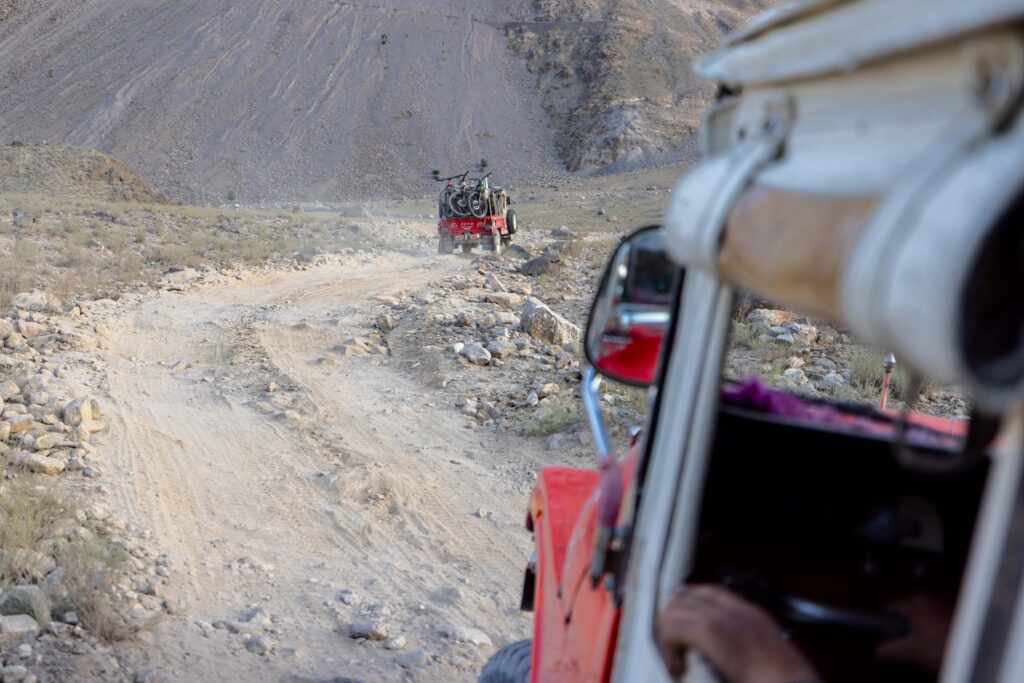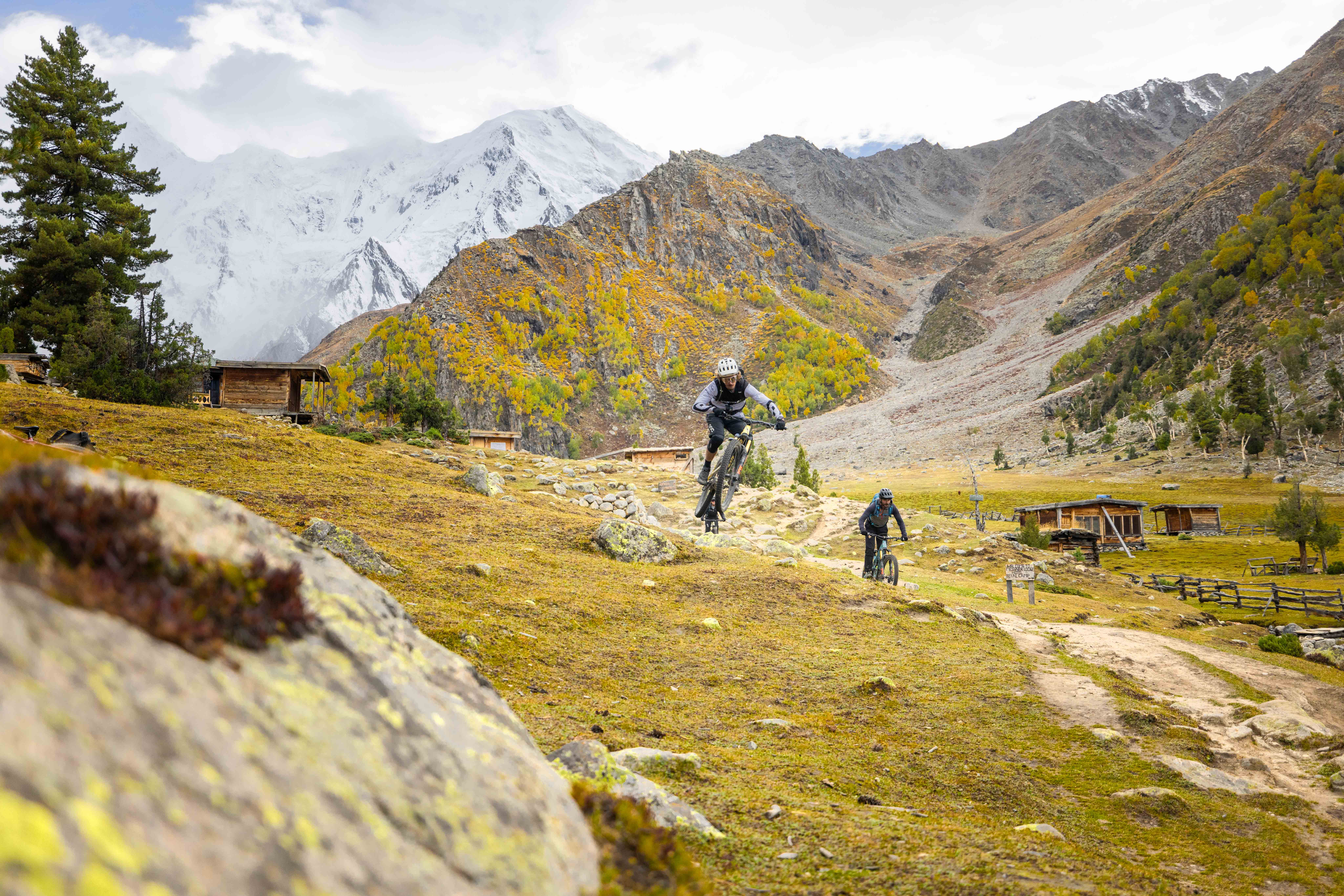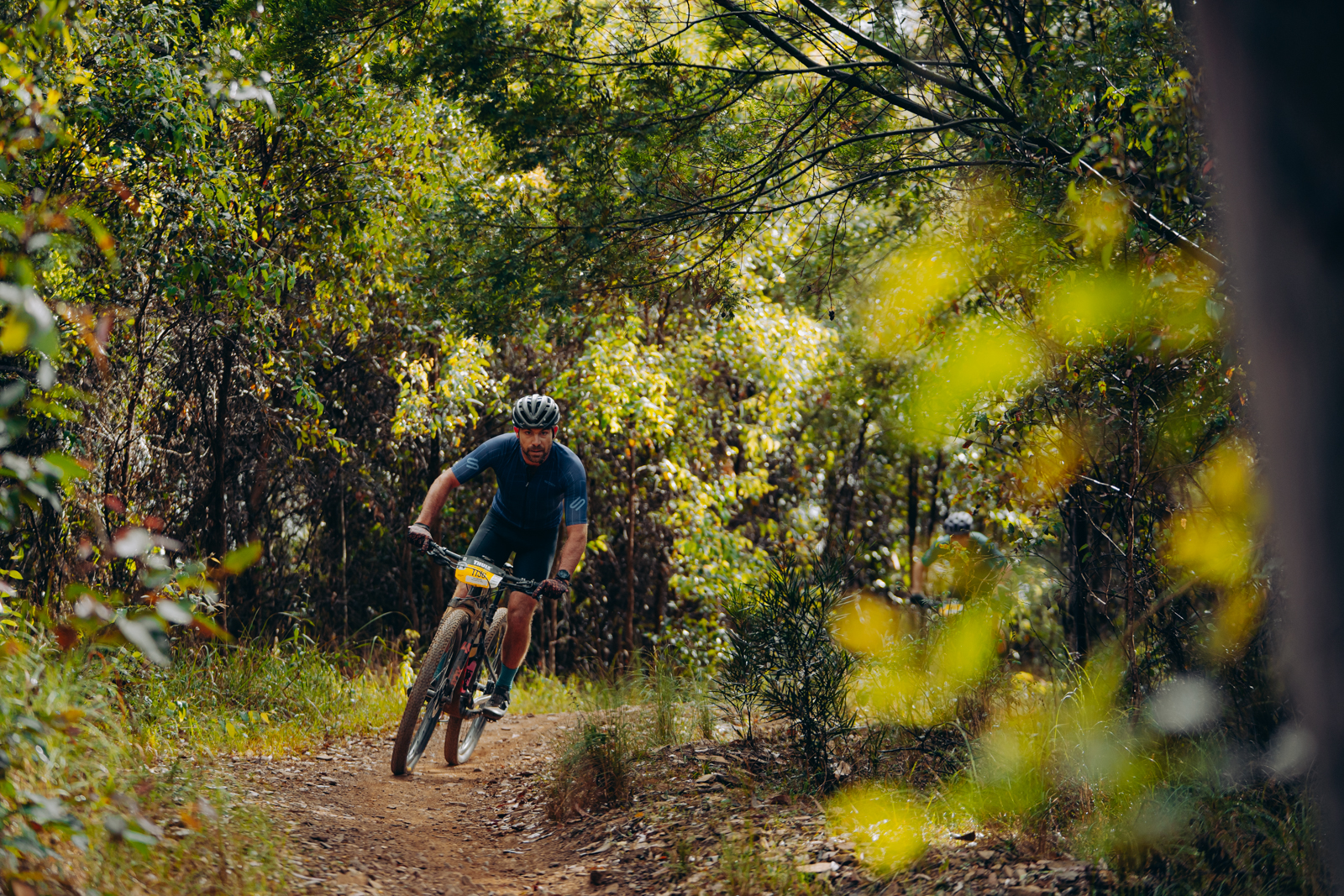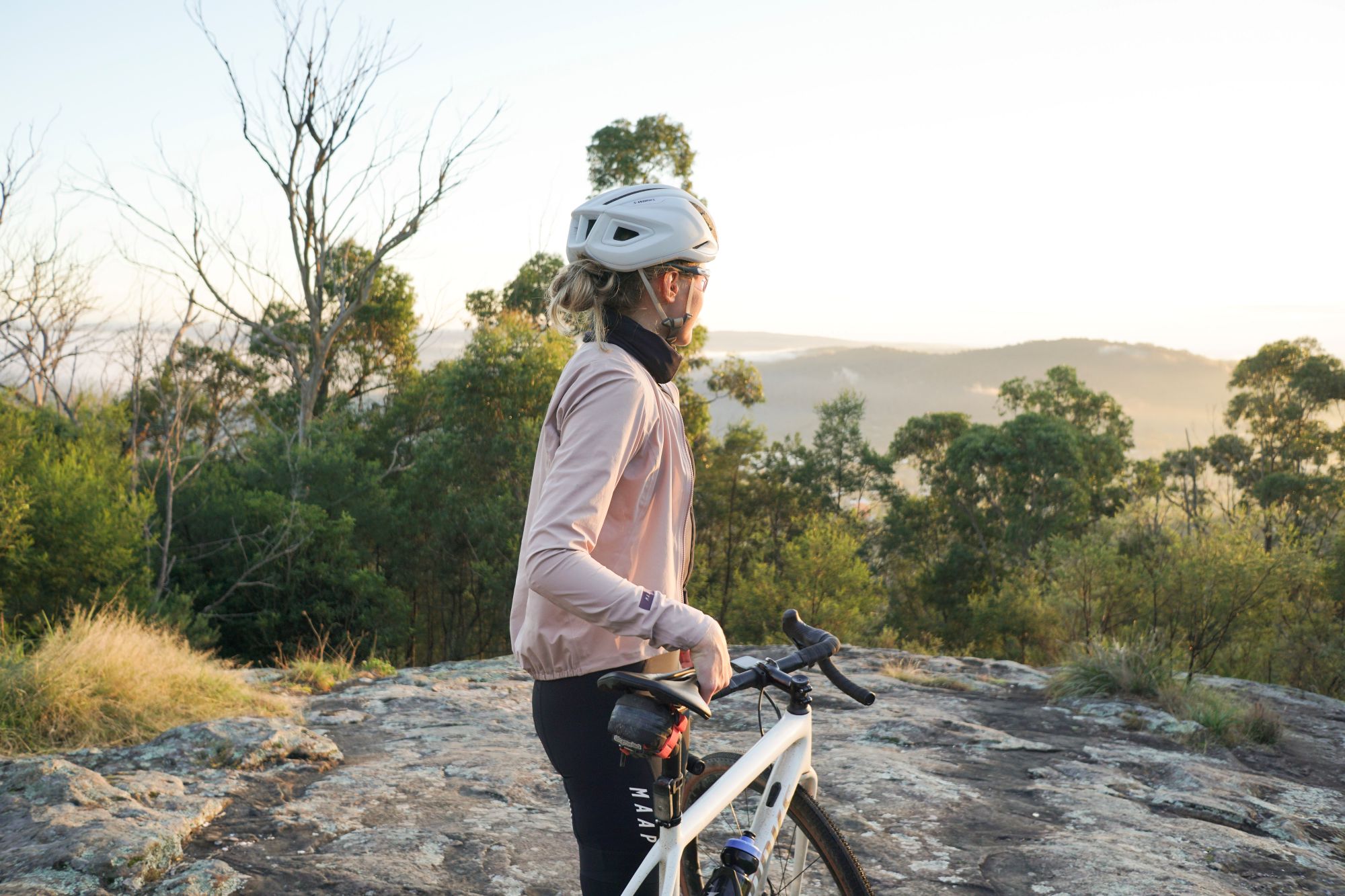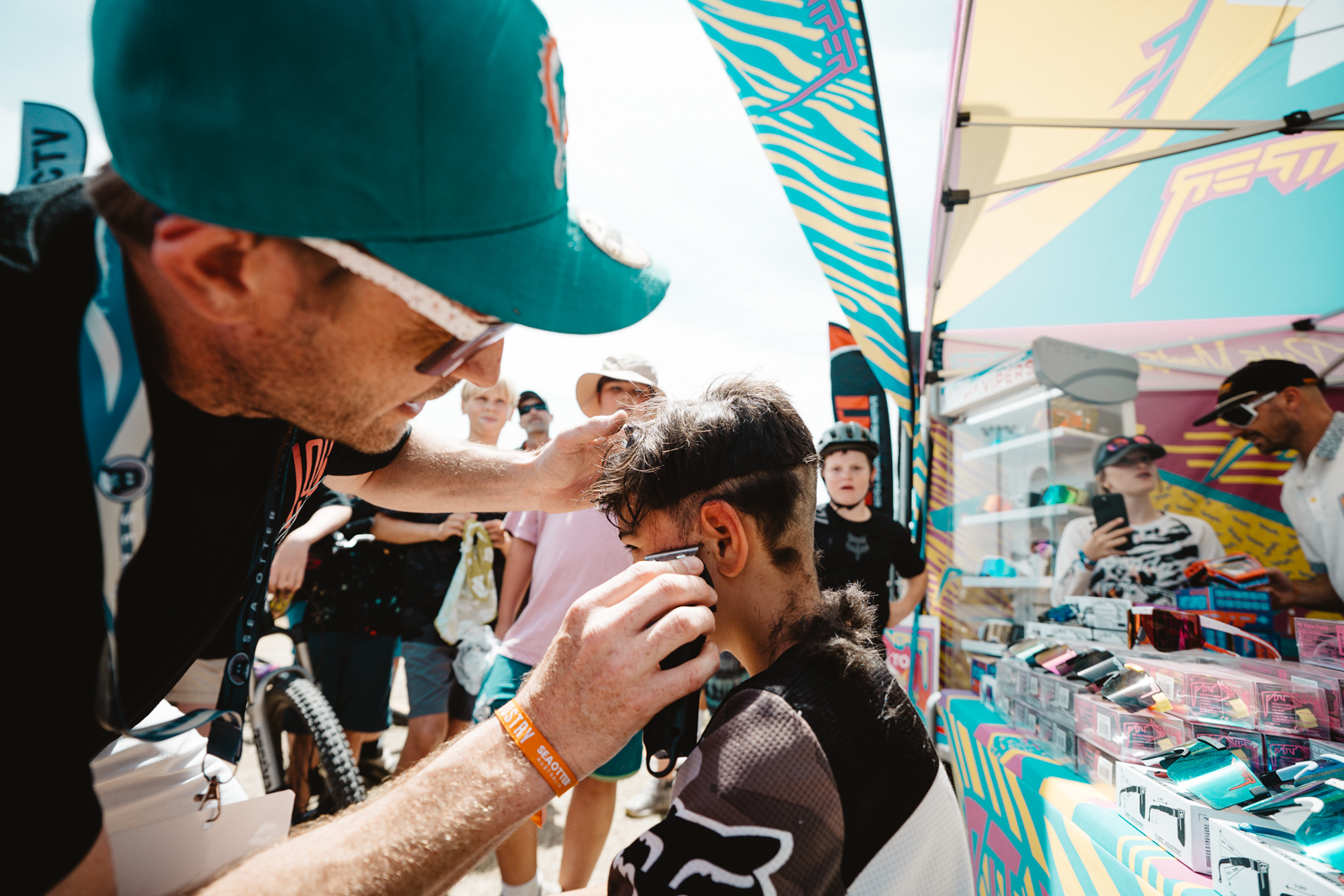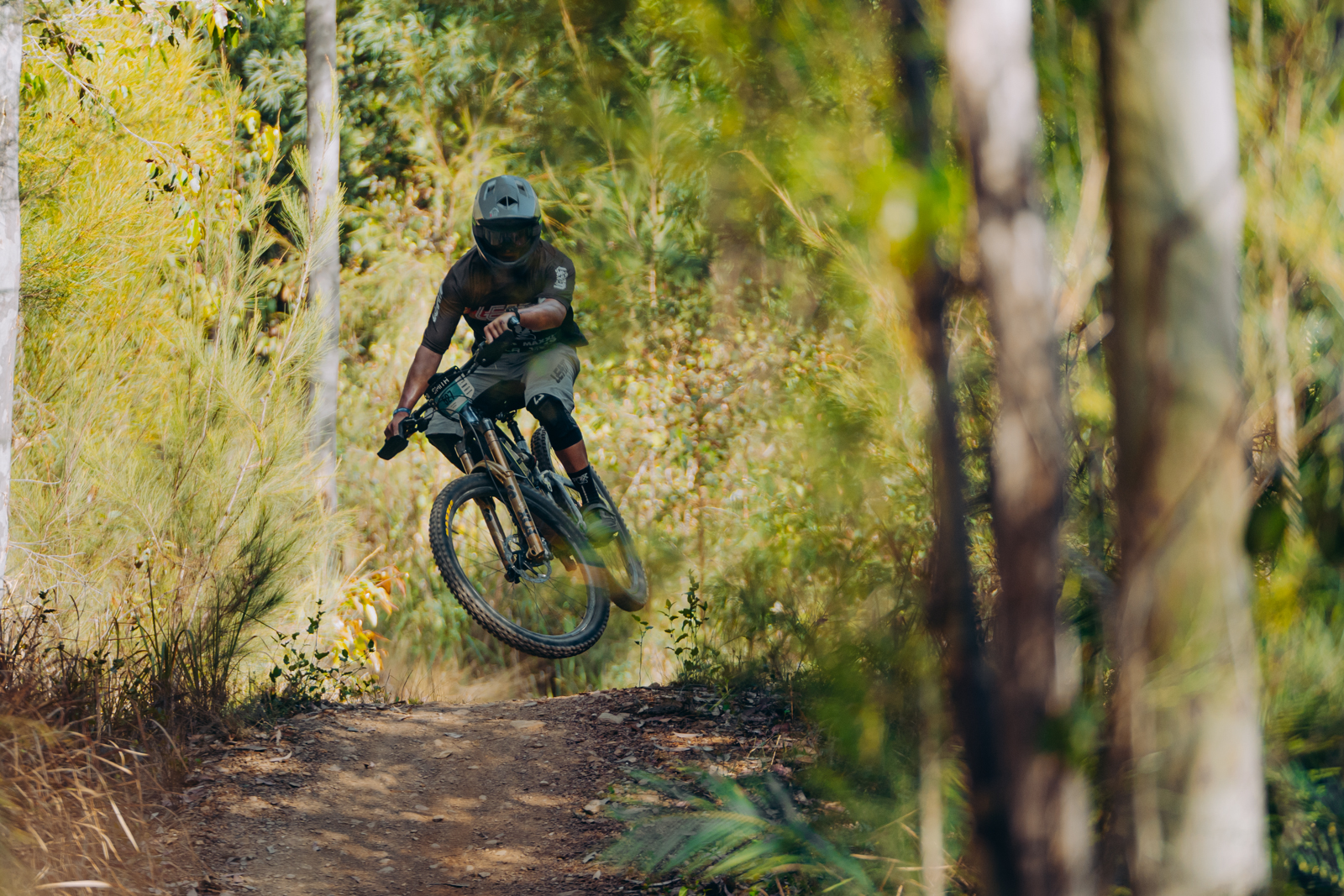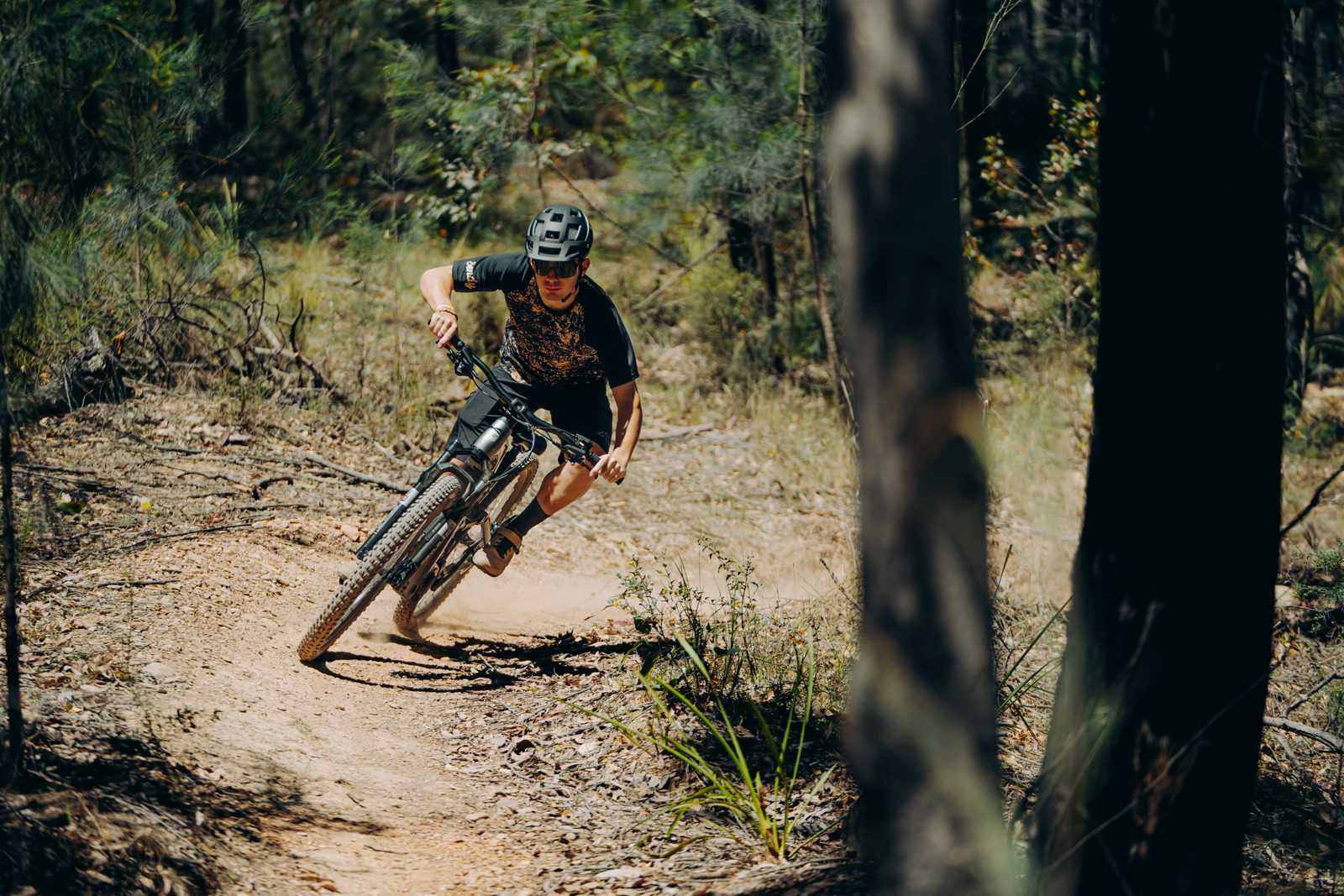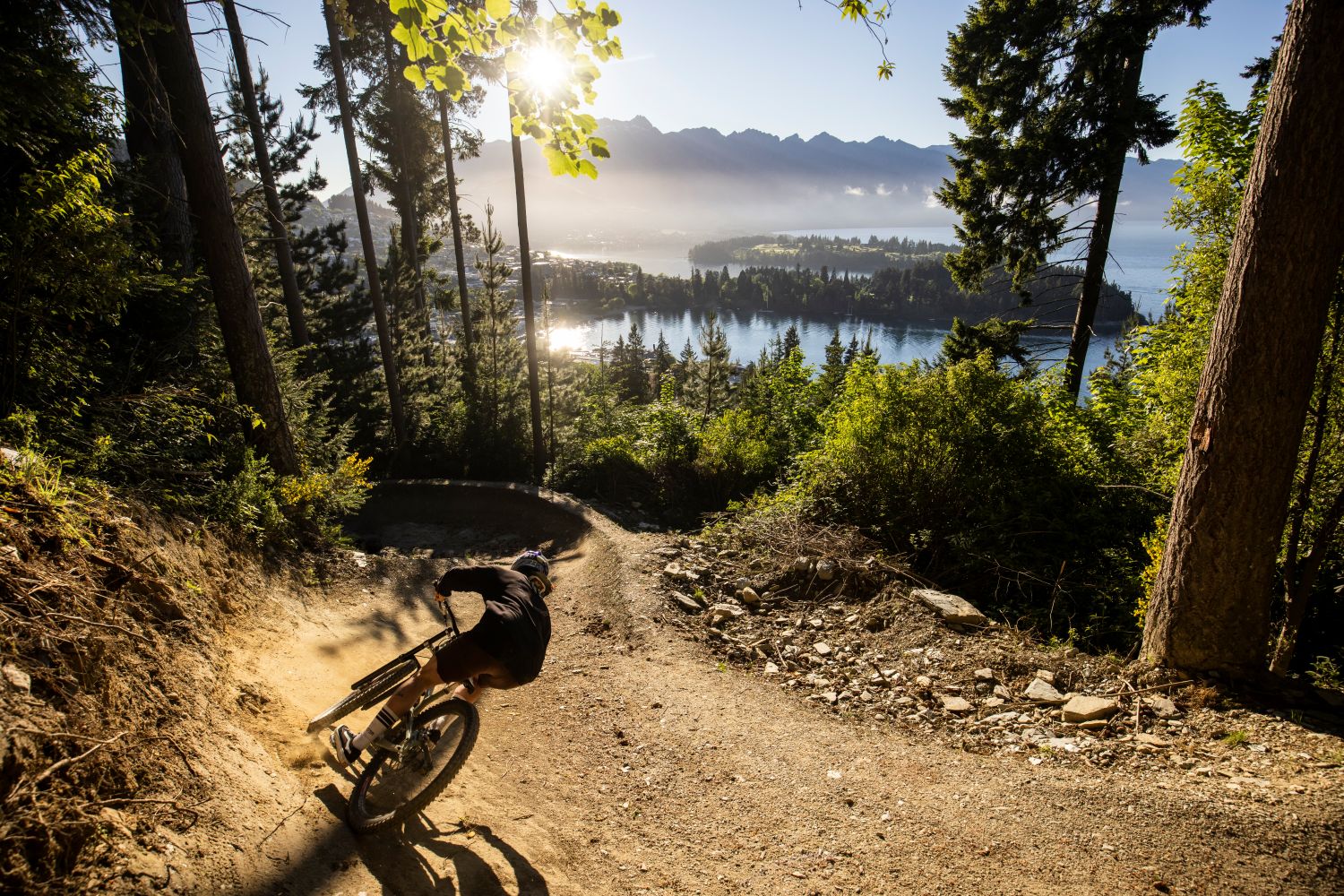Why Gilgit-Baltistan Should Be on Every Mountain Biker’s Bucket List
Words and Photos by Mike Dawson
We explore the untamed beauty of Gilgit-Baltistan by mountain bike. Home to towering peaks, remote villages, and bucket list-level adventure.
At the intersection of rugged terrain and high-altitude adventure, Gilgit-Baltistan is a dreamscape for mountain bikers. Tucked away in northern Pakistan, the region is renowned for its towering peaks, deep valleys and awe-inspiring landscapes. For those with a penchant for the outdoors, it represents the last frontier of exploration.
In 2024, a team of six diverse riders embarked on an expedition to this enigmatic region, eager to uncover its hidden mountain biking trails. Our objective was clear: to find new paths, push the limits of endurance, and revel in the beauty of a remote part of the world few outsiders had set foot in. This is the story of our journey, our challenges, and the epic riding we discovered in Gilgit-Baltistan.
The journey begins
It was early, and the cold was biting. We were camped high in the Karakorum Mountains in northern Pakistan, and no one had gotten much sleep. Our unacclimatised bodies were struggling to breathe at high altitude. A night spent battling headaches, tight stomachs, and general discomfort had already shown us how tough this journey would be. But there we were, a team of six riders, on the first day of an ambitious expedition to uncover the hidden mountain biking potential of Pakistan.
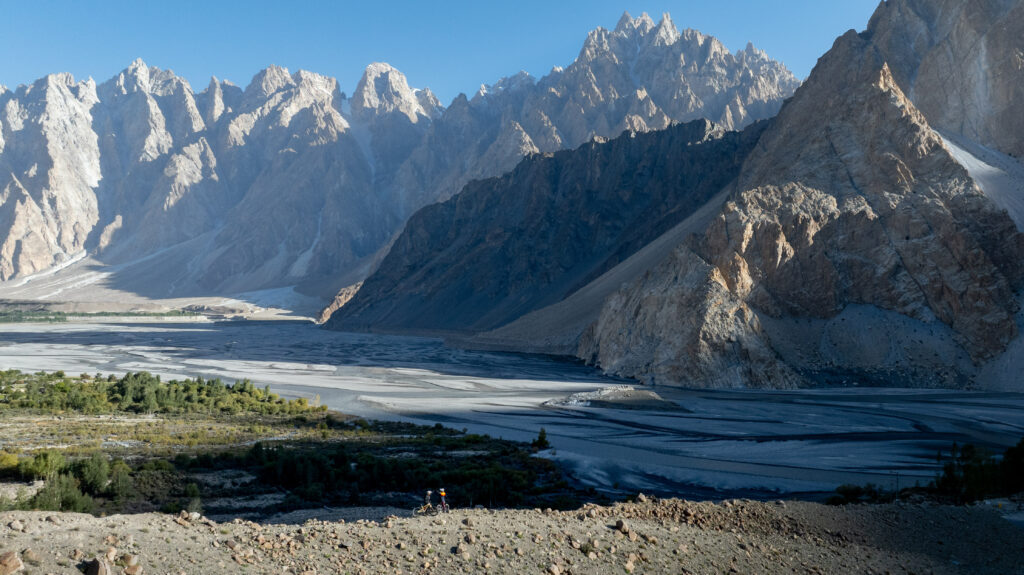
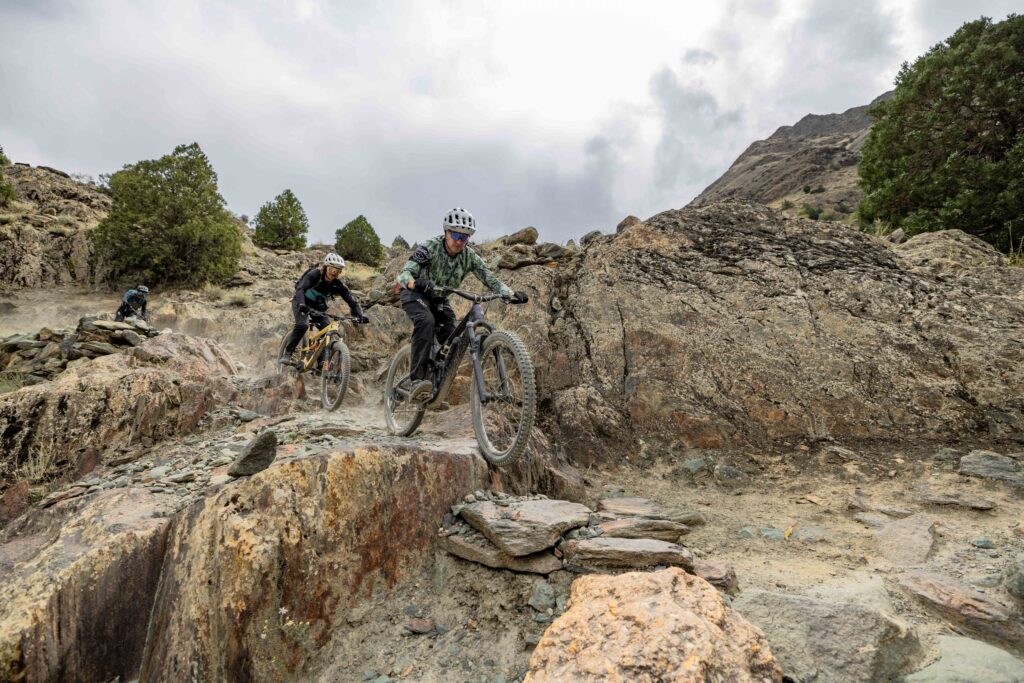
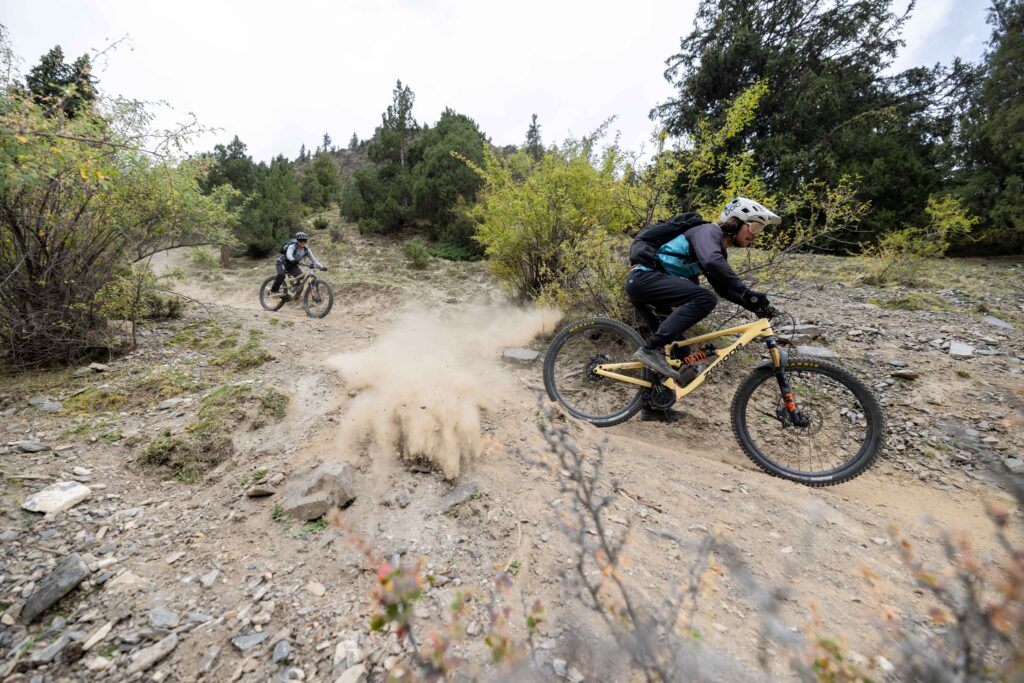
This was not a trip to ride through the familiar landscapes of Rotorua or the remote mountains of New Zealand. No, we were in the heart of Gilgit-Baltistan, a place few, if any, riders have ventured. It was a dream destination for anyone passionate about Adventure, a region known for its breathtaking beauty, towering peaks, and rugged terrain. Little did we know that our search for trails would become more than just a riding experience—it would transform into an exploration of culture, community, and the unexplored beauty of Pakistan’s northern reaches.
The Team
Our expedition team consisted of a motley crew of seasoned professionals, adventurers, and newcomers to the high mountains. Our collective knowledge of biking spans continents, disciplines, and decades, making for a dynamic and interesting mix of skills.
Jamie Garrod – Known as the mastermind behind New Zealand Mountain Biking, Jamie is a professional guide with years of experience leading riders through some of the most beautiful (and challenging) trails in the world. His passion for guiding and his deep knowledge of terrain and safety were invaluable on this trip.
Matt Miller – Founder of Brake Ace, an innovative riding company, Matt brought his technical expertise and a flair for discovering new bike technologies. His insights into bike setup and performance were crucial, especially given the varying conditions we encountered at high altitudes.
Je@ Carter – A trail builder with decades of experience, JeZ is as much at home with a shovel as he is with a bike. He’s built trails around the globe and has ridden almost every corner of the world. His contribution to this expedition was invaluable, not only in terms of trail expertise but also in finding riding lines that made the most of the terrain.
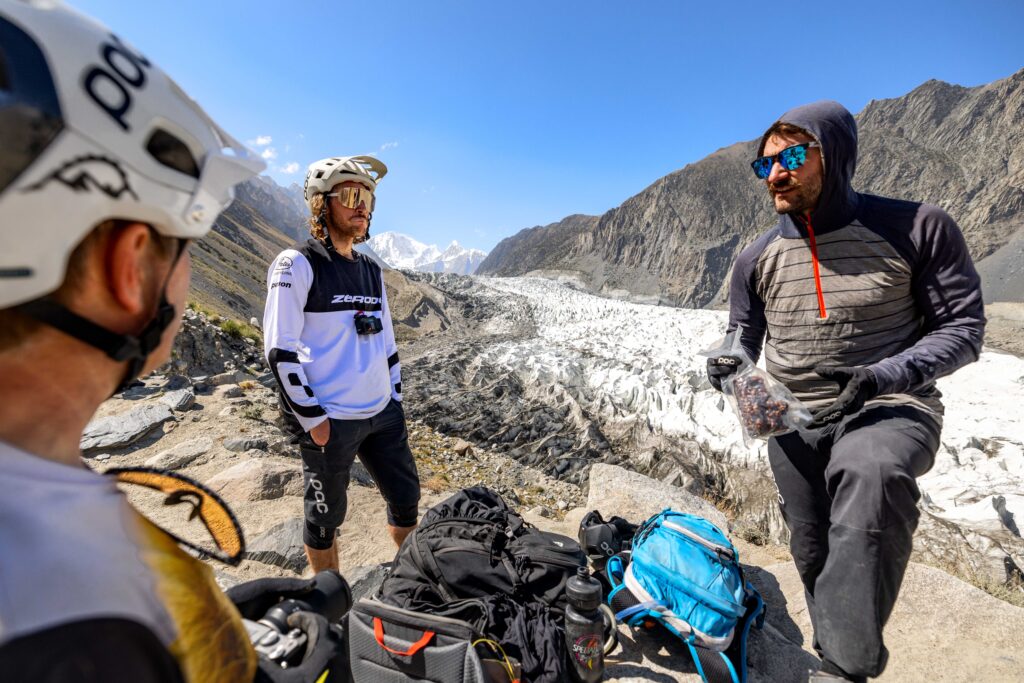
Adam Kadervak – Our filmer and documentarian, Adam’s job was to capture every breathtaking moment of the expedition. Equipped with state-of-the-art cameras and drones, he turned our rides into cinematic experiences. His ability to get the perfect shot—while keeping pace with riders at high altitudes—was truly impressive.
Rosie Clarke – A local rider from Rotorua, Rosie was on the lookout for an adventure that would push her limits. A skilled rider with a love for exploration, she added energy and enthusiasm to the team. It was her first experience in such extreme environments, and watching her tackle these trails was a highlight of the trip.
Mike Dawson – A relative newcomer to adventure mountain biking, joining the mastermind Jamie, to plan this expedition to explore the altitude, terrain, and the sheer beauty of the surroundings.
Why Pakistan?
The idea to ride in Pakistan first came about in a somewhat unconventional way. After a quick ride around Whakarewarewa Forest, the seeds of the expedition were planted.
Over a couple of beers, the team began discussing the idea of exploring an entirely new, yet unknown, part of the world. It was Mike who first pitched the idea “What if we could explore the trails of northern Pakistan?”. Jamie needed little convincing and from there the crew grew.
For most people, Pakistan’s name conjured images of remote mountains, steep peaks, and vast, untamed wilderness – combined with geo-politics, war and terrorism. It seemed like the perfect setting for an adventure.
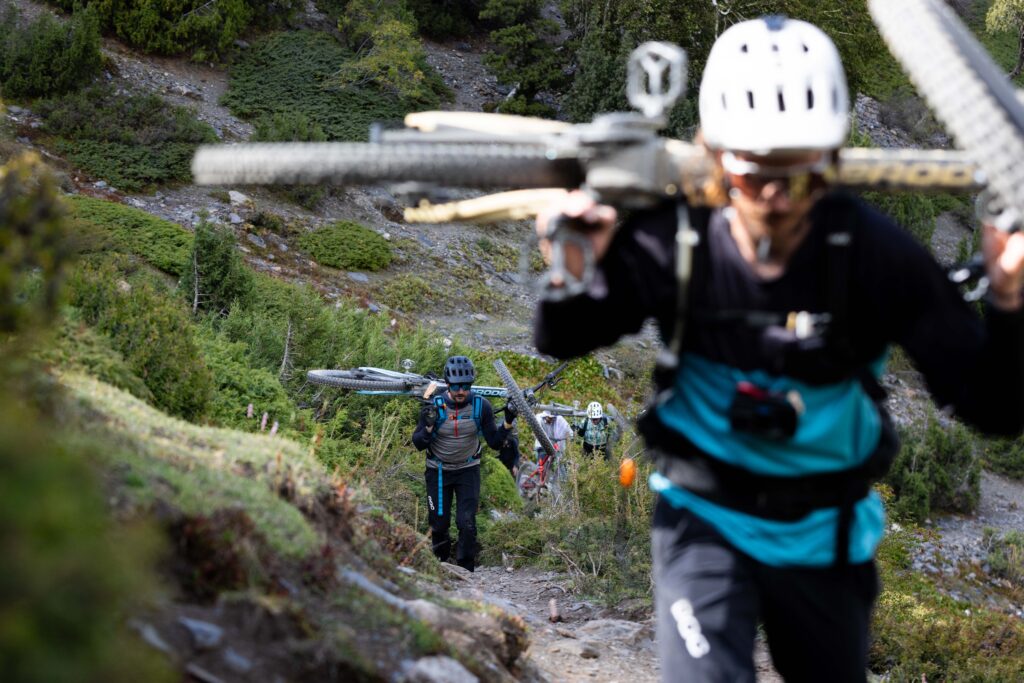
Our goal was simple: fly to northern Pakistan and explore the hidden trails. We didn’t know exactly what we’d find, but the prospect of discovering a new frontier was irresistible. Pakistan isn’t typically the first place you think of when it comes to mountain biking adventures. However, this was exactly what intrigued us; an area bordering the mighty Himalaya and the Karakoram Ranges.
We knew that remote regions like these held untapped potential, and we felt the time was right to discover what might be hidden in those high-altitude valleys. It took months of planning, countless emails, and an immense amount of research to get everything in motion. We reached out to local guides, secured the necessary permits, and began working to ensure that we had everything needed for a safe and successful journey. What began as a casual conversation in a Rotorua pub was now an all-in adventure, and we were ready to embark on what promised to be the experience of a lifetime.
Embarking to Skardu
Flying into Skardu this all became a little more real. Skardu Airport, perched in a narrow valley, provided the perfect gateway to one of the most remote and stunning regions on Earth. Disembarking the plane in the small but bustling town, nestled at the foot of some of the highest peaks on the planet, takes your breath away.
Jagged peaks – many of them over 7,000 meters – rise from the earth like ancient sentinels watching over the land.
We quickly settled in and were greeted by local people with warmth and curiosity. The hospitality of the people here would define our entire journey, from our first meal to our last ride. After some quick adjustments to the bikes, we were ready to embark on the real adventure.
Our team of six was already feeling the weight of the journey, the anticipation of the days ahead merging with the fatigue of hours spent on planes from New Zealand. Before we hit the trails, there was a challenge to be faced: getting our bikes from Skardu to the heart of the mountains. The solution, as it turned out, came in the form of two old Toyota Hilux trucks.
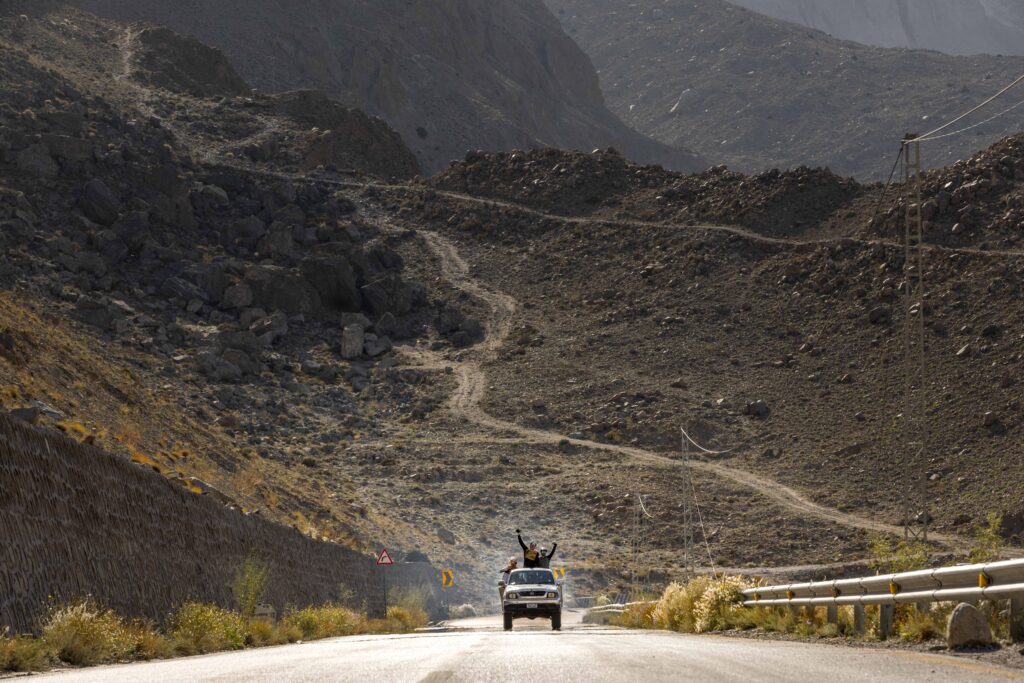
There was no luxury of bike racks. Jamie Garrod, leader of the team, glanced at the two trucks. “We’ll need to figure out how to get these bikes around,” he said, squinting at the bed of the first Hilux, “they’re not exactly big”. The Hiluxes were in surprisingly good mechanical condition for their age, though their beds were lined with scratches and dents from years of hard use.
Matt, the innovator behind Brake Ace, was the first to come up with an idea, “what if we buy some sleeping pads and carpet?”. Adam Kadervak, the documentary filmmaker and a man of few words, nodded in agreement. He was keen to get moving, but equally committed to documenting every moment. Moments later, with the bikes hanging on the back, we headed out along the Indus River, towards the mountains, towards adventure.
The road was a chaotic mixture of dust, rocks, and unpredictable terrain. The Hiluxes, despite their age and weathered appearance, performed perfectly. The drivers, swerving between trucks, bikes and cars, in between the inattention caused by phone calls and social media checks. As we swerved through narrow mountain paths, the crew was enjoying differing degrees of nervousness. The bikes, nestled in the back, seemed to hold their breath with every sharp turn and jolt. Despite many close calls both bikes and riders survived.
Day One: The Trek to Fairy Meadows
Fairy Meadows is perhaps the most known tourist spot of North Pakistan. A lush, green plateau that sits at the base of Nanga Parbat, the ninth-highest mountain in the world. While it’s known for its trekking routes, few have explored it on two wheels. Our plan was simple: ride the well-known trekking route and see what we could uncover. The logic was that years of hiking may have worn a ridable descent into the hillside.
Crossing the Indus River in the baking afternoon sun, we arrived at the base of the Fairy Meadows road, on the edge of the Karakorum Highway. It was a scene of absolute chaos. Our vehicles weren’t able to navigate the treacherous road that climbs steeply from the valley floor with daunting 1000m sheer drops, and little margin for error – so we had to recruit local transport. After 2 hours haggling with local drivers a price was set, bikes loaded and as the sun set we headed off into the remote regions.
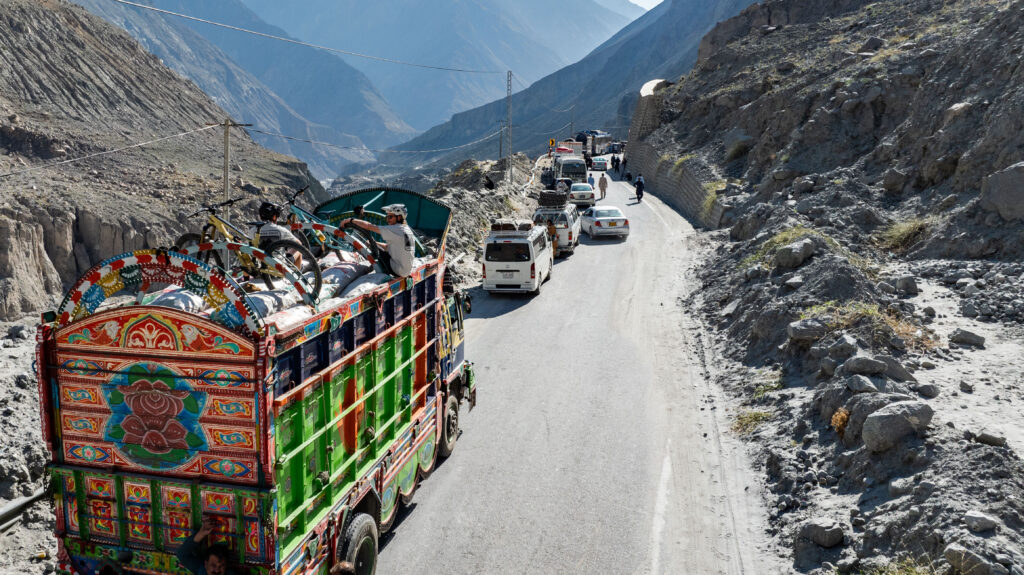
By late afternoon, the landscape unfolded before us in breathtaking beauty as we climbed up into the highlands. The trucks had done their job, and the sun hung low over the rugged peaks of the Karakoram, casting long shadows across the rough, dusty roads. We were left with our bikes at a wash out – days of rain had washed away a section of road. We had to make our way around it by foot, trying not to look the 500ft down into the river below and wonder ‘what if…’.
We continued on foot up the Fairy Meadows track in the dark. It was a relentless test of willpower, hungry and tired. With only our headlamps casting narrow beams of light, we stumbled over loose rocks and jagged roots, the steep trail snaking upwards over uneven terrain. The weight of our mountain bikes, slung over our shoulders or pushed by the handlebars, made each step feel heavier. The air was thin, our breath shallow, and the cold bit through every layer of clothing. The sound of our boots crunching on the gravel was the only rhythm as we pushed on. The higher we climbed, the more the altitude drained us, our bodies unaccustomed to the thin mountain air. But there was no turning back. We pushed on, driven by the promise of the pristine Fairy Meadows, the warmth of a bed and a Pakistani dinner waiting at the top.
As the sun rose the following morning, we awoke to a magnificent site. On the skyline the dramatic peak of Nanga Parbet created a stunning scene, a falling glacier making its way down the valley. Eating breakfast was in the most scenic of spots. We headed further upwards, pushing our bikes to the high view point before dropping into the descent.
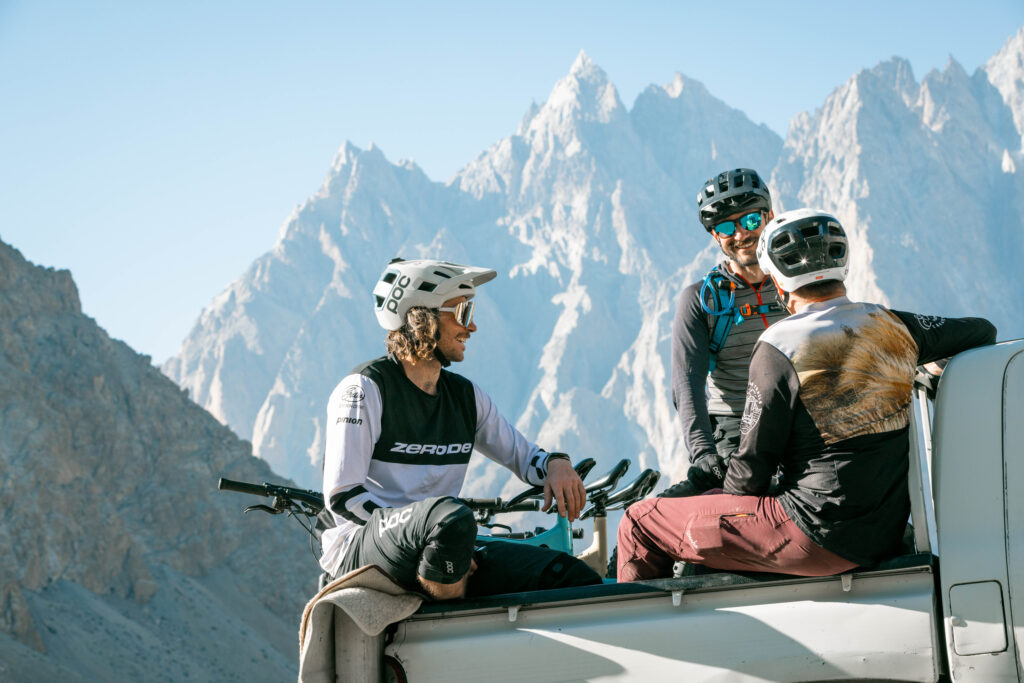
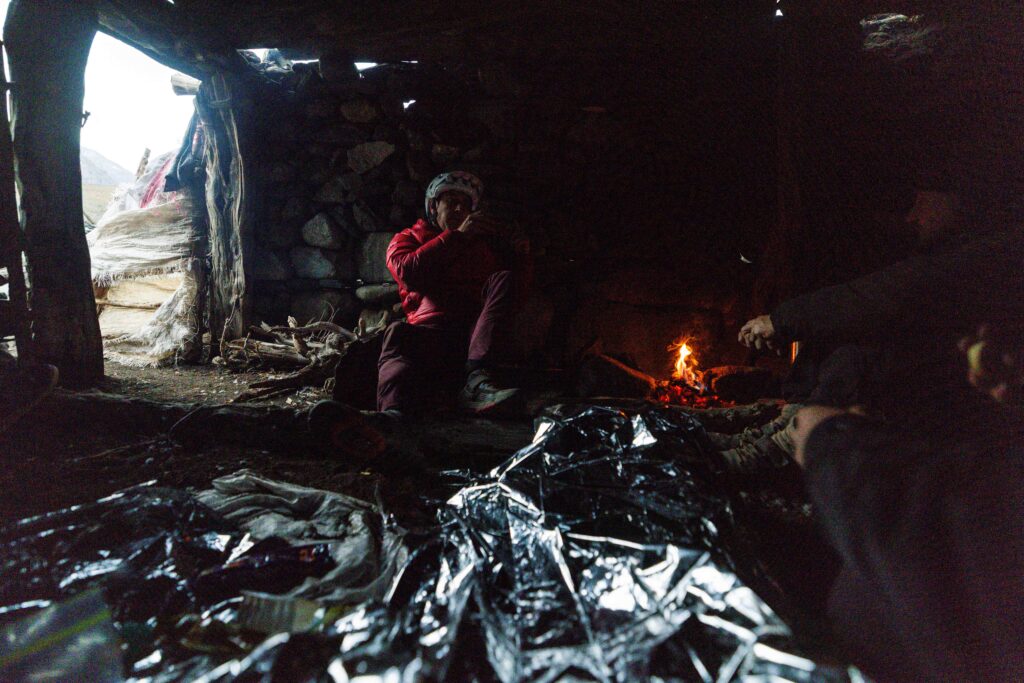
The ride was epic. Natural endless flow combined with large boulders creating rock features. We whooped and hollored on our descent, enjoying the natural features. The challenge of the terrain was real, but the beauty was unmatched. Along the way, we crossed streams, passed through small villages, and navigated steep, rocky sections that tested both our physical endurance and technical riding skills.
By the time we arrived back at Fairy Meadows, we were all fatigued but exhilarated. The sunsetting view of Nanga Parbat was nothing short of spectacular. Its snow-capped peak loomed majestically above us, towering over the lush meadows below. We spent the evening setting up camp, resting, and soaking in the surreal atmosphere as the sunset on another insane Pakistani day.
Over 2500 metres of descent to the Indus Valley floor awaited us. We set off early the following morning. Steep sections of exposed trail combined with flow, tech and all round fun. This descent felt like the perfect combination of discovery riding. Exposure created nervousness and speed was kept in check.
Each rider was in their element — whether it was Jamie making technical maneuvers look effortless, Matt pushing the limits of his bike setup, or Rosie conquering a steep section. Skidding into the carpark, high fives were thrown around like candy, before the waiting Hiluxes were loaded up and headed for the next descent.
Rakaposhi Base Camp
In my opinion, no trip to northern Pakistan would be complete without experiencing the majestic beauty of Rakaposhi Peak. Rakaposhi, standing at 7788 meters, is the 27th highest mountain in the world. Its beauty is almost surreal.
We spent several days in the area, scouting trails and exploring the surrounding valleys before landing on the ridgelines of Rakaposhi as our primary objective. Towering over the upper Honza Valley, we all thought this section of trail would be what we had come to Pakistan for. The surrounding landscape is rugged. Snow covers the upper slopes, glaciers cascade downward and rivers flow steeply towards the valley floor.
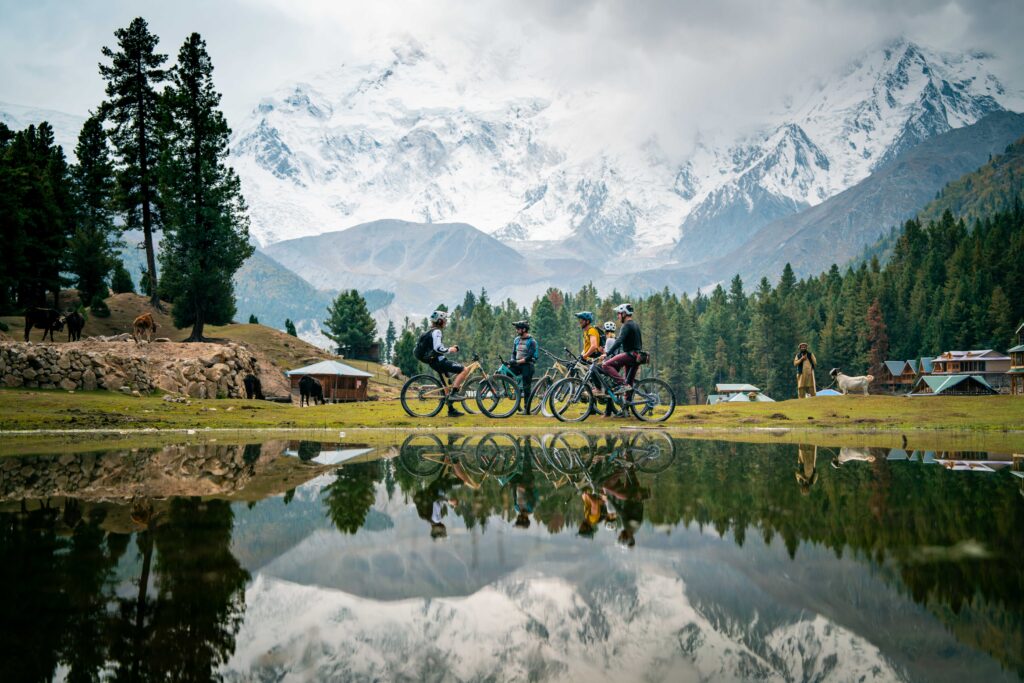
The climb was tough. It was hot; again the sun beat down on us as we began to ascend out of the valley up a steep path. The team had found its rhythm. We had traversed, explored and played around in enough of the area to know what was ahead of us and were starting to formulate a picture of the trails that could be built here.
The team was tired. Matt Miller was struggling, the Pakistani cuisine had got him. Rough guts and the resulting dehydration had sapped the energy out of him. When you added the intense heat into the mix, it made for a tough day, but after a perfectly timed drink stop for a cold NEXT Cola at a shack enroute, he was back on track and ready for the lure of the peaks ahead.
The rugged terrain on the ascent was giving a guide for what we were in for on our descent. For the team we were now nearing altitudes above 4000 meters, the lack of oxygen was beginning to take its toll. Every step felt like an effort, combined with the heavy loads on our shoulders with overnight gear, bike and equipment. The speed was slow at best.
We were weary of altitude sickness and we adjusted our pace to ensure we didn’t push too hard. As we neared the base camp, the sheer size and scale of Rakaposhi was overwhelming. At the final corner before the basecamp (our destination for the night) we were greeted with a spectacular sight. The giant glacier flowed from the highest slopes right past the camp. The beauty of the place was unfathomable. The region felt wild and untamed, and the serenity of the mountains was almost otherworldly. At this point, it wasn’t just about riding, it was about feeling the raw power of nature and embracing the unknown.
The elation of the team was contagious. Sitting in an area so unique – big mountains, miles from home and a realisation that we were sitting at the top of a trail and that the entire descent was ridable. The steeps were managable, linked together with endless flow, built over years of foot traffic and weather. Better still, the higher moisture content in the area meant more shrubs, trees and hero dirt leading to for greater grip on the trail.
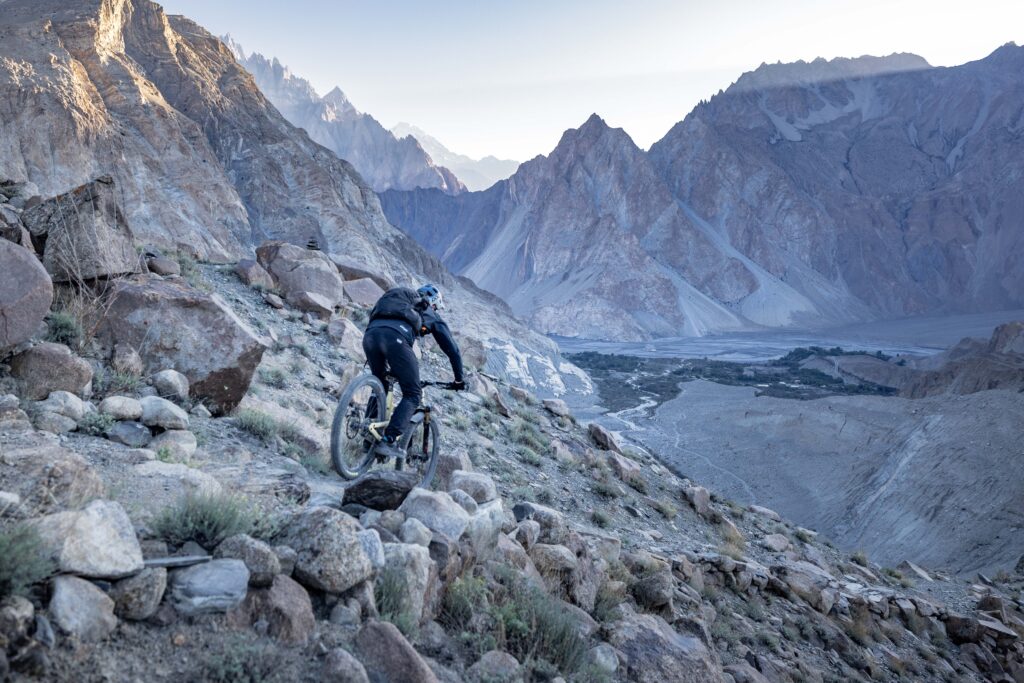
There was no denying that we had found exactly what we were looking for: an unknown trail, primed for riding. Built by nature. The potential for new lines was endless, and we were eager to see what else the land had to offer. In the afternoon, Adam got his cameras out to document the beauty of the trails, the landscapes, and our journey. He captured us riding through forests, across alpine meadows, and along rocky ridgelines, all while the backdrop of snow-capped peaks remained a constant reminder of how remote and wild this place truly was.
At dawn we awoke and dragged our bikes up for sunrise over the Rakaposhi Glacier. Jamie attempted to ride the rocky and exposed ridgeline before returning to camp for a hearty breakfast of fried eggs, tea and chapati – a breakfast of champions. From there it was all systems go.
Descending from the alpine meadow camp the way we had climbed meant 1500m of descent over 10km of single track passing through alpine scree, alpine meadows, steep rocky exposed sections, and wooded rooty areas. The crew rode section after section regrouping for a short break before setting off at pace.
After 2 hours of playfully making our descent we arrived at the Honza River – filled with stoke.
A New Frontier for Mountain Biking in Gilgit-Baltistan
Our expedition to Gilgit-Baltistan was nothing short of epic. From the bustling streets of Skardu to the serene landscapes of Fairy Meadows and the awe-inspiring Rakaposhi Base Camp, we experienced a part of the world few have had the privilege to explore on a mountain bike. The region’s potential for mountain biking is immense, offering riders the chance to not only experience a stunningly remote landscape but to push physical and mental limits in ways that few places can provide. As we flew back from Skardu, exhausted but invigorated, I couldn’t help but reflect on how transformative the trip had been. For all of us, this expedition was about more than just riding bikes, it was about discovering new challenges, new places and connecting with a landscape that is as wild as it is beautiful while exploring the unknown.
For those looking for the ultimate adventure in mountain biking, Gilgit-Baltistan is a place that should be on every rider’s radar. The trails are waiting and the mountains are calling. One of the most pleasant surprises of the trip was the incredible local support we received. Pakistan’s northern regions, despite their remoteness, have a vibrant local community that is incredibly welcoming to travelers. Our guides, cooks, and logistics teams were not only highly skilled but deeply passionate about their land. They provided everything we needed to succeed, from navigating the rugged terrain to keeping our spirits high in the face of adversity.
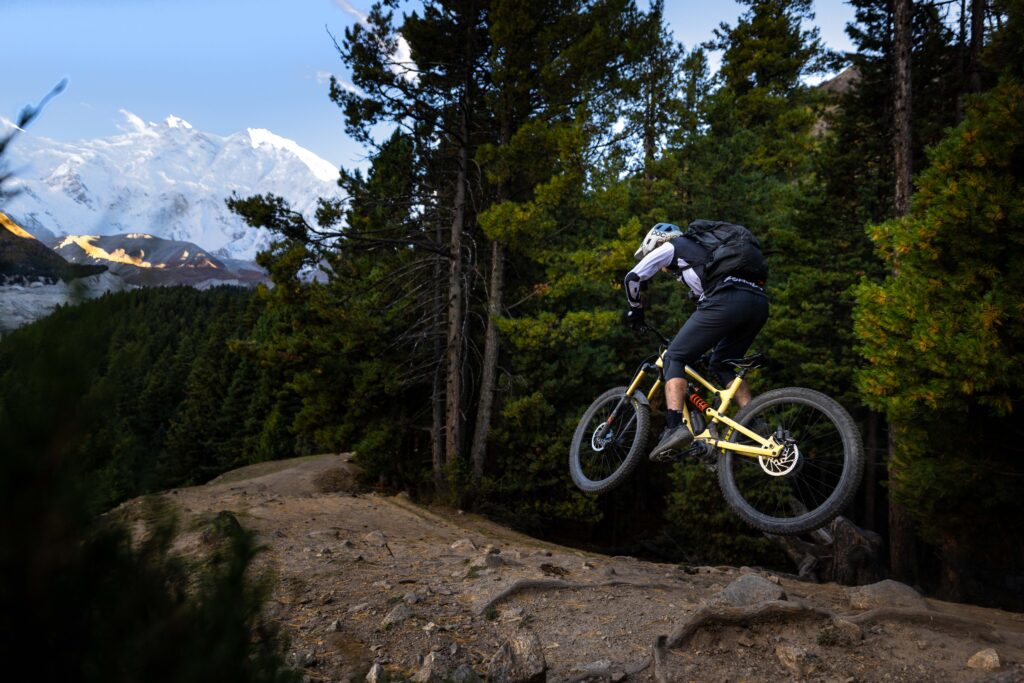
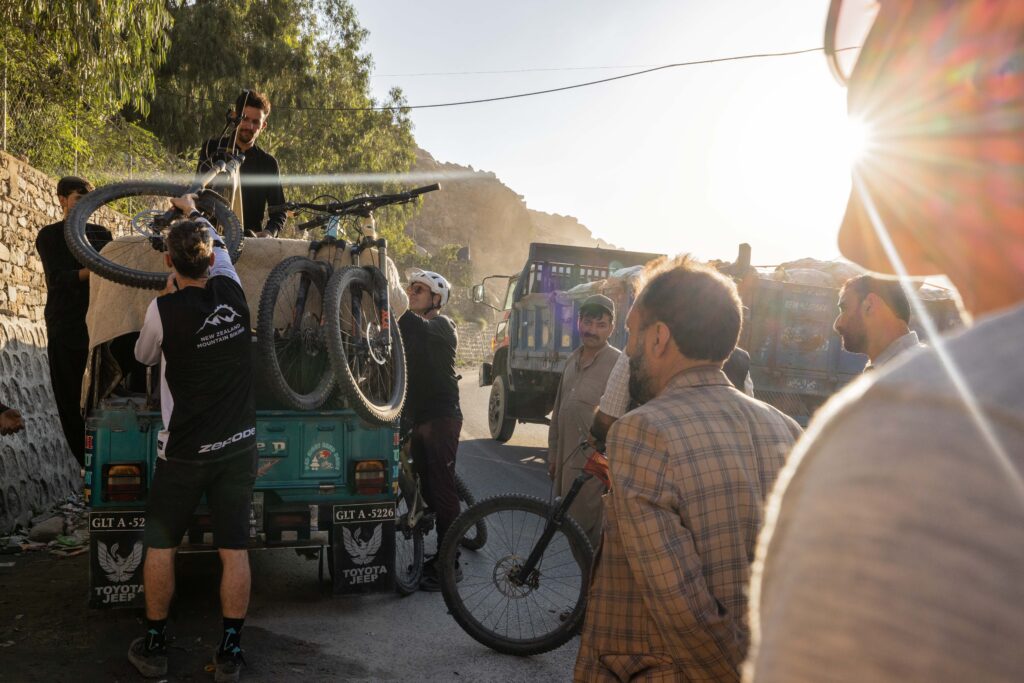
The connection between the locals and the land was evident. Many of the people we met had lived their entire lives in the shadow of these majestic peaks, and they treated the mountains with reverence and respect. As mountain bikers, it was humbling to see how closely they coexisted with the natural world, and it made the experience even more enriching. It also reminded us of the importance of local knowledge, which proved invaluable in finding trails that were otherwise invisible to the untrained eye.
The riding potential in northern Pakistan was beyond anything we could have imagined. Gilgit-Baltistan, with its high-altitude deserts, alpine meadows, and towering mountains, offers some of the most unique and challenging riding opportunities in the world. The region is still relatively untapped by mountain bikers, but its rugged terrain offers endless possibilities for new lines and trails.
Culture and Safety in Pakistan
Contrary to what many might believe, Pakistan is a country full of rich culture, history, and hospitality. The locals, particularly in the northern regions, were incredibly welcoming and eager to share their lives and stories with us. We were often invited into homes for tea or food, and the kindness we received was humbling. Despite being in a relatively remote area, there was always a sense of safety, with the local people watching over us as we navigated the trails.
